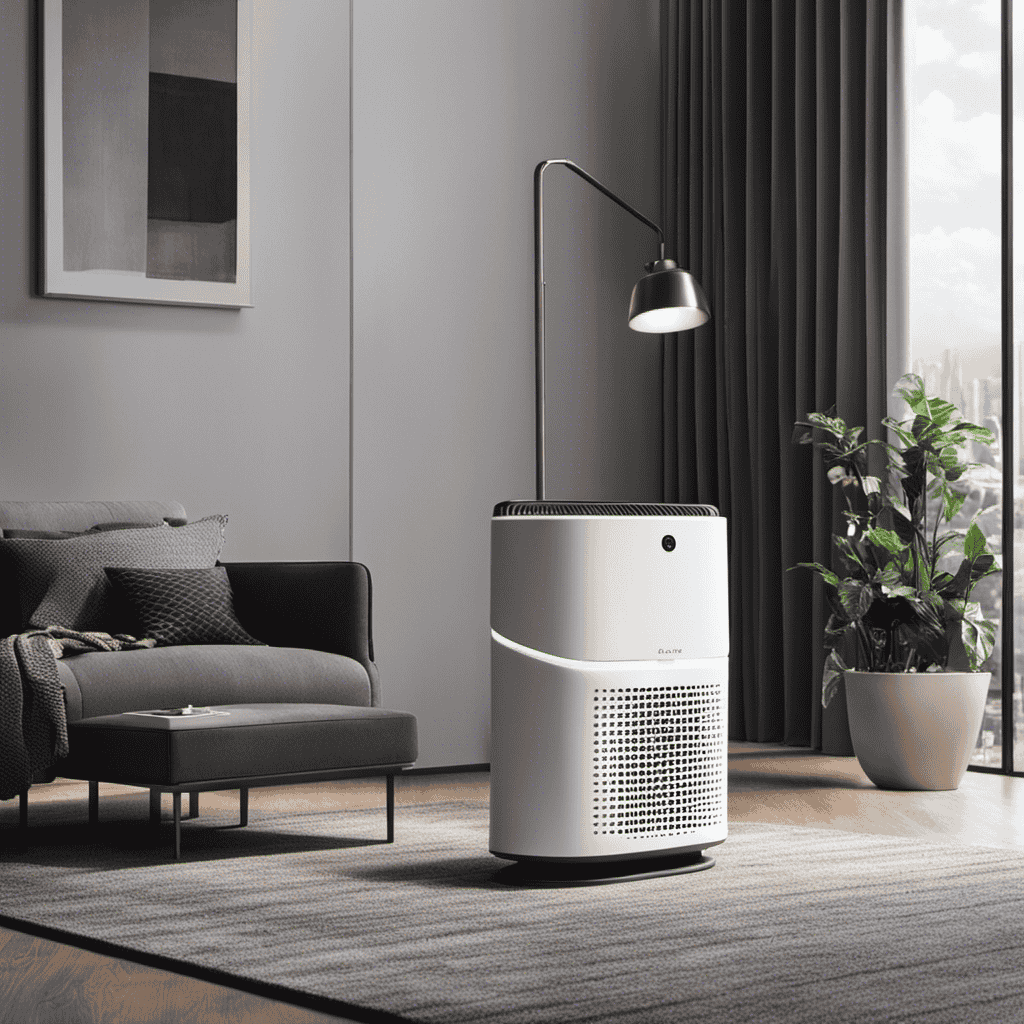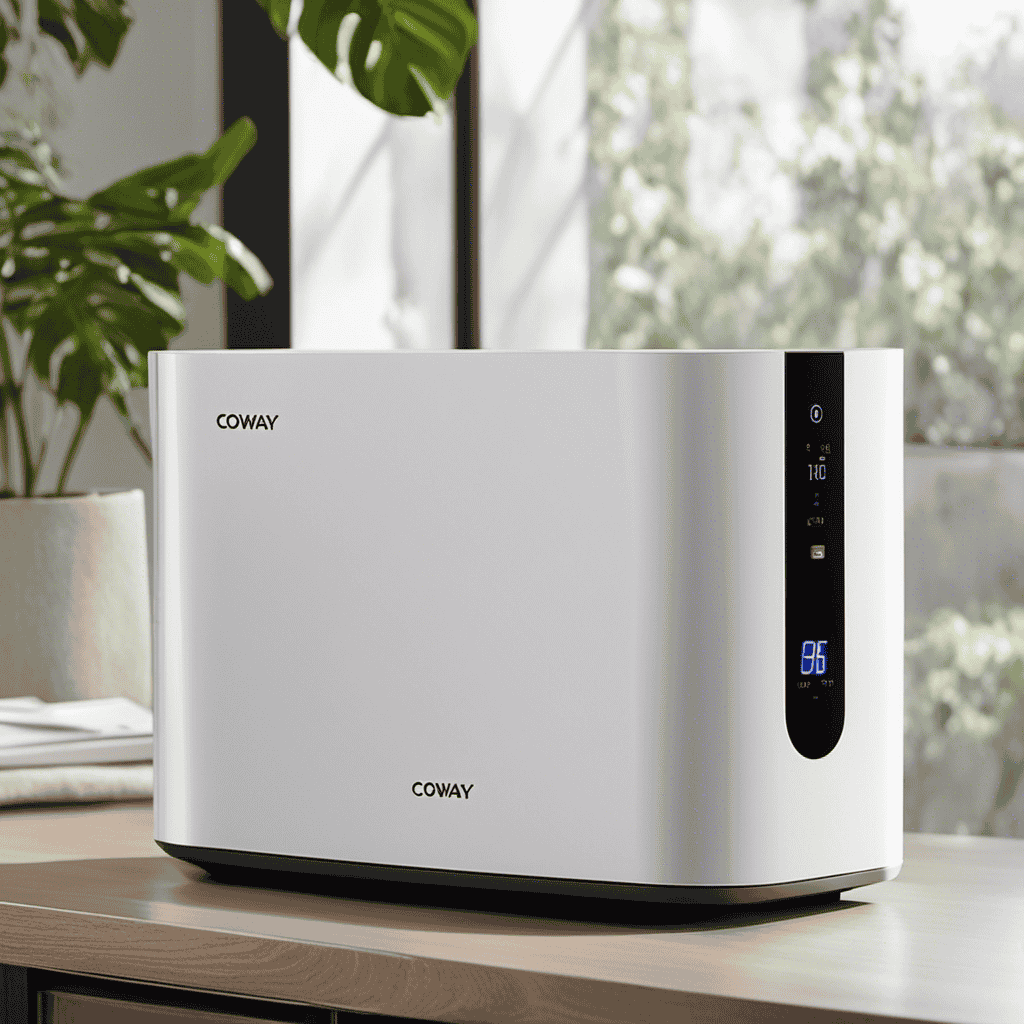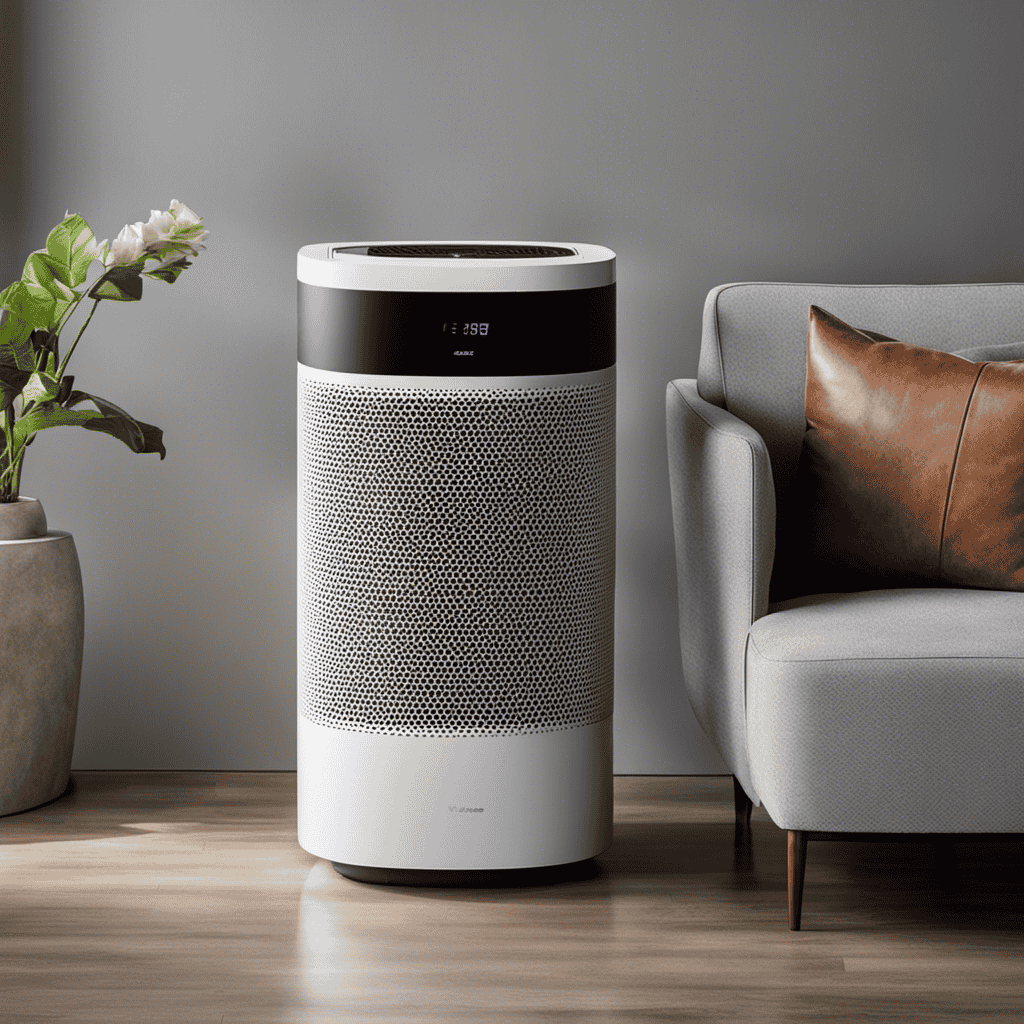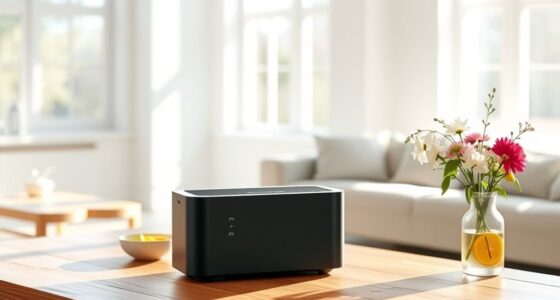Would you like to guarantee that the air you’re breathing is clean and refreshing?
If so, then it’s time to replace the filter in your Holmes Air Purifier. In this article, I will guide you through the process of replacing the filter with ease and precision.
With the right tools and a few simple steps, you’ll be able to enjoy the benefits of a cleaner and healthier home environment.
So, let’s get started and take control of the air quality in your space.
Key Takeaways
- Check the model number on your Holmes air purifier and identify the specific filter requirements for your model.
- Visit the Holmes website or contact customer service for the compatible replacement filter.
- Turn off and unplug the air purifier before replacing the filter.
- Evaluate your specific needs and choose the right filter, considering options like HEPA filters, carbon filters, UV-C filters, and electrostatic filters.
Determine the Correct Replacement Filter for Your Holmes Air Purifier
To determine the correct replacement filter for your Holmes air purifier, you’ll need to check the model number. Choosing the right model is crucial to ensure optimal performance and clean air in your home. Holmes offers a wide range of air purifiers, each with specific filter requirements. By identifying the model number, you can easily find the compatible replacement filter.
The first step in replacing the filter is to locate the model number on your Holmes air purifier. It is usually located on the back or bottom of the unit. Once you have the model number, you can visit the Holmes website or contact their customer service to find the exact replacement filter.
After obtaining the correct model number, follow these steps to replace the filter. First, make sure your air purifier is turned off and unplugged from the power source. Open the front cover or access panel to reveal the filter compartment. Remove the old filter by pulling it out gently. Dispose of the old filter properly.
Now, take the new replacement filter and insert it into the empty filter compartment. Make sure it is securely in place. Close the cover or access panel and plug in your air purifier. Turn it on and enjoy clean, fresh air in your home.
With the correct replacement filter in hand and the knowledge of the necessary steps, you are ready to gather the necessary tools and supplies for the filter replacement process.
Gather the Necessary Tools and Supplies
When it comes to gathering the necessary tools and supplies for replacing the filter in your Holmes Air Purifier, there are a few key points to consider.
First and foremost, you will need a replacement filter that is compatible with your specific model of air purifier.
Secondly, it is important to have a clean, dry cloth or towel on hand to wipe down any surfaces before and after the filter replacement process.
Lastly, having a small screwdriver or other tool to remove the cover of the air purifier can be helpful, as some models may require this step in order to access the filter.
Essential Tools Required
You’ll need a few essential tools to replace the Holmes air purifier filter. Here are the top three tools you’ll need for a smooth filter replacement process:
-
Screwdriver – A screwdriver is essential for removing the screws that hold the filter in place. Make sure to choose a screwdriver that fits the size and type of screws used in your specific Holmes air purifier model.
-
Cleaning Brush – Before installing the new filter, it’s important to clean the purifier’s internal components to ensure optimal performance. A cleaning brush with soft bristles will help you remove any dust or debris from the purifier.
-
Microfiber Cloth – When handling the new filter, it’s crucial to avoid touching the surface that captures the airborne particles. A microfiber cloth will help you handle the filter without leaving any fingerprints or smudges.
With these essential tools, you’ll be well-equipped to carry out the filter replacement process smoothly. Now, let’s move on to choosing the right filter.
Choosing the Right Filter
Once you have gathered the essential tools, it’s time to consider which filter is the right choice for your needs. When it comes to air purifier maintenance, choosing the right filter is crucial. There are different types of filters available, each with its own benefits. To help you make an informed decision, I have created a table comparing the most common types of air purifier filters:
| Filter Type | Description |
|---|---|
| HEPA | High Efficiency Particulate Air filters that can capture up to 99.97% of airborne particles |
| Carbon | Effective at removing odors and harmful gases |
| UV-C | Utilizes ultraviolet light to kill bacteria, viruses, and mold spores |
| Electrostatic | Attracts and traps airborne particles using an electrostatic charge |
Choosing the right filter depends on your specific needs. If you suffer from allergies or asthma, a HEPA filter would be the best option as it can remove common allergens such as dust, pollen, and pet dander. If you want to eliminate unpleasant odors, a carbon filter would be more suitable. For extra protection against bacteria and viruses, a UV-C filter is recommended. It is important to consider the benefits of using air purifiers and select a filter that addresses your concerns effectively.
Turn Off and Unplug Your Holmes Air Purifier
Before proceeding to turn off and unplug your Holmes Air Purifier, it is important to take note of some safety precautions.
First and foremost, ensure that the device is switched off before unplugging it from the power source. This will prevent any potential electrical mishaps or damage to the purifier.
Secondly, handle the power cord with care, avoiding any twisting or bending that could lead to fraying or breakage.
Lastly, always use the designated plug and outlet for your Holmes Air Purifier, as using an incompatible power source could result in malfunctions or even pose a safety hazard.
Safety Precautions for Unplugging
To safely unplug the Holmes air purifier filter, make sure that the device is turned off and unplugged from the power source.
Here are some safety precautions to follow when unplugging your air purifier:
- Avoid pulling the power cord forcefully, as it may damage the cord or the device itself.
- Keep your hands dry and don’t touch any metal parts while unplugging the device to prevent electrical accidents.
- Store the air purifier in a safe and dry place after unplugging it, away from any water sources or flammable materials.
By following these safety measures, you can ensure that you unplug your Holmes air purifier filter without any mishaps.
Now, let’s move on to the next step: properly shutting down the device.
Properly Shutting Down Device
Now that we have discussed the safety precautions for unplugging the Holmes air purifier, let’s move on to the next step: properly shutting down the device. This is an important step to ensure the safety of both the user and the device itself.
To properly shut down the Holmes air purifier, follow these troubleshooting tips:
- Turn off the power switch located on the purifier.
- Unplug the device from the electrical outlet.
- Wait for a few minutes before handling the purifier to allow any residual electricity to dissipate.
By following these steps, you can avoid any potential electrical hazards and ensure a safe shutdown of the device. Always remember to handle the purifier with care and respect its power source.
In the table below, you can find a summary of the safety precautions and troubleshooting tips for properly shutting down the Holmes air purifier:
| Safety Precautions | Troubleshooting Tips |
|---|---|
| Turn off power switch | Unplug device from electrical outlet |
| Wait a few minutes before handling |
Remember to always prioritize safety when handling any electrical device.
Access the Filter Compartment
First, you’ll need to locate the latch that opens the filter compartment on your Holmes air purifier. This latch is typically located on the side or back of the device.
Once you have located the latch, follow these steps to access the filter panel:
-
Gently press the latch and release it to open the filter compartment. Be careful not to apply too much force or you may damage the latch or the compartment.
-
Once the compartment is open, you will see the filter panel. Carefully remove the panel by pulling it towards you. Take note of how the panel is positioned so you can easily put it back later.
-
Troubleshooting filter compartment issues: If you are having trouble opening the filter compartment, make sure the device is turned off and unplugged. Sometimes, a power reset can help resolve any issues. If the latch is stuck or not functioning properly, you may need to contact the manufacturer for further assistance.
Remember to handle the filter compartment with care to avoid any accidental damage.
Now that you have accessed the filter panel, you can proceed with replacing the filter in your Holmes air purifier.
Remove the Old Filter
Once you’ve opened the filter compartment, carefully remove the old filter from its position. When handling the old filter, it is important to take certain safety precautions to avoid any potential hazards.
Firstly, ensure that the air purifier is turned off and unplugged before starting the replacement process. This will prevent any electrical accidents or injuries. Additionally, it is recommended to wear gloves to protect your hands from any dust or debris that may have accumulated on the filter.
To remove the old filter, gently grasp it by the edges and pull it out of the compartment. Be careful not to apply too much force, as this could damage the filter or the surrounding parts of the air purifier. Once the old filter is removed, place it in a plastic bag or wrap it in a newspaper to contain any dust or dirt.
Before discarding the old filter, take a moment to clean the filter compartment. Use a soft brush or a vacuum cleaner with a brush attachment to remove any dust or debris that may have accumulated. This will ensure that the new filter can function optimally.
Following these safety precautions and cleaning instructions will help you properly remove the old filter from your Holmes air purifier, preparing it for the installation of a new filter.
Clean the Filter Compartment
Proper filter maintenance is crucial for maintaining the optimal performance of your air purifier. Regularly cleaning and replacing the filters not only ensures cleaner air, but also extends the lifespan of the unit.
Clean filters provide numerous benefits, such as reducing allergens, eliminating odors, and improving overall air quality.
In this discussion, we will also cover troubleshooting common issues that may arise with your air purifier filters, helping you identify and resolve any problems effectively.
Proper Filter Maintenance
To keep your Holmes air purifier operating efficiently, make sure you regularly clean and replace the filter. Proper filter maintenance is crucial for optimal performance and air quality. Here are three essential filter replacement tips and maintenance techniques:
-
Follow the manufacturer’s guidelines: Consult the user manual for specific instructions on how often to replace the filter. Generally, it is recommended to replace the filter every 3-6 months, depending on usage and air quality.
-
Vacuum or wash reusable filters: If your Holmes air purifier has a reusable filter, remove it and gently vacuum off the accumulated dust and debris. Alternatively, some filters can be washed with water and mild detergent. Make sure to completely dry the filter before reinserting it.
-
Monitor filter condition: Regularly check the filter for signs of wear and tear, such as discoloration or damage. If the filter appears worn or no longer effectively captures particles, it is time for a replacement.
Benefits of Clean Filters
Regularly cleaning and replacing your air purifier’s filters ensures optimal performance and improved air quality. The benefits of regular cleaning include removing dirt, dust, allergens, and other particles from the air, reducing the risk of respiratory issues and allergies. Cleaning the filters also helps to maintain the efficiency of the air purifier, ensuring that it continues to effectively remove pollutants from the air. Additionally, regular cleaning prolongs the lifespan of the filters, saving you money in the long run. However, it is equally important to replace the filters at the recommended intervals to maintain the air purifier’s effectiveness. Over time, filters become clogged and less efficient, which can compromise the air quality in your home. By regularly cleaning and replacing your air purifier’s filters, you can enjoy cleaner and healthier air.
| Benefits of Regular Cleaning | Importance of Replacing Filters |
|---|---|
| Removes dirt and allergens | Maintains air purifier’s efficiency |
| Reduces respiratory issues | Saves money in the long run |
| Improves air quality | Ensures cleaner and healthier air |
Troubleshooting Common Issues
Now that we understand the benefits of clean filters, let’s delve into troubleshooting common issues that may arise when replacing your Holmes air purifier filter.
As an expert in air purifiers, I have encountered several situations where users face challenges during this process. Here are three common problems to watch out for:
-
Air purifier noise: If your air purifier suddenly starts making an unusual noise after replacing the filter, check if the filter is properly installed and secure. Loose or misaligned filters can cause vibrations and noise.
-
Incorrect filter selection: One common mistake is using the wrong filter for your specific model. Always double-check the compatibility of the replacement filter with your Holmes air purifier to ensure optimal performance.
-
Neglecting pre-filter cleaning: Many users forget to clean or replace the pre-filter, leading to reduced efficiency and potential damage to the main filter. Remember to clean or replace the pre-filter regularly to maintain the longevity of your air purifier.
Install the New Filter
When replacing the Holmes air purifier filter, make sure you insert the new filter correctly. Proper installation is crucial for the optimal functioning of your air purifier. To help you with the process, here are some detailed installing instructions and troubleshooting tips.
Firstly, before replacing the filter, make sure your air purifier is turned off and unplugged. This will prevent any accidental damage or injury.
Next, locate the filter compartment, usually located at the back or side of the unit. Open the compartment and carefully remove the old filter.
Now, take the new filter and remove it from its packaging. Pay attention to the arrows or markings on the filter that indicate the correct direction of airflow. Insert the new filter into the compartment, making sure it fits snugly and securely. Close the compartment and ensure it is properly sealed.
Once the new filter is installed, plug in your air purifier and turn it on. Monitor the unit for any unusual noises or malfunctions. If you encounter any issues, refer to the troubleshooting tips provided in the user manual or contact the manufacturer for assistance.
Reassemble the Filter Compartment
To reassemble the filter compartment, follow these steps:
-
Align the filter: Make sure the filter is aligned correctly with the compartment. Check for tabs or notches that need to be matched up. This ensures proper airflow and performance.
-
Secure the latches: Once the filter is aligned, secure the latches or clips on the compartment. Double-check that they are locked in place to prevent air leaks.
-
Test for sealing: After reassembling, turn on the air purifier and monitor for air leakage. If you notice gaps or air escaping, check the filter alignment and latches. Adjust as needed for a proper seal.
Plug in and Turn On Your Holmes Air Purifier
Once you’ve plugged in and turned on your Holmes air purifier, you can begin enjoying cleaner and fresher air in your environment. However, before you start using your air purifier, it’s important to take some safety precautions.
Make sure to read the user manual thoroughly to understand the proper usage and maintenance of your specific model. Additionally, ensure that the power cord is in good condition and not damaged. Always plug the air purifier directly into a grounded outlet to avoid any electrical hazards.
If you encounter any issues while using your Holmes air purifier, here are a few troubleshooting tips to help you resolve them.
Firstly, check if the power switch is turned on and if the unit is receiving power. If not, try plugging the air purifier into a different outlet. Secondly, make sure that the filters are clean and properly installed. If the filters are dirty or clogged, they may affect the performance of the air purifier. Lastly, if you notice any unusual sounds or odors coming from the unit, it may indicate a problem. In such cases, it is advisable to contact the manufacturer or a qualified technician for assistance.
Test and Monitor the Performance of Your New Filter
Make sure you regularly check and monitor the performance of your new filter to ensure it is effectively cleaning the air in your environment. Testing and monitoring the filter efficiency is crucial to maintain a healthy and pollutant-free atmosphere.
Here are three key steps to help you evaluate the performance of your new filter:
-
Conduct air quality tests: Use an air quality monitor to measure the levels of pollutants in your environment before and after installing the new filter. Note down the test results and compare them to determine the filter’s effectiveness in reducing contaminants such as dust, pollen, pet dander, and smoke particles.
-
Evaluate filter lifespan: Keep track of the filter’s recommended lifespan and replace it as required. Check the manufacturer’s guidelines to determine the average lifespan of your specific filter model. Regularly inspect the filter for signs of wear and tear or clogging, as these can affect its efficiency.
-
Monitor airflow and noise levels: Pay attention to the airflow and noise levels produced by the air purifier. A decrease in airflow could indicate a clogged or dirty filter, while excessive noise may suggest a malfunction. Regularly clean or replace the filter if necessary to maintain optimal performance.
Frequently Asked Questions
How Often Should I Replace the Filter in My Holmes Air Purifier?
I replace the filter in my Holmes air purifier every 3-6 months. Regular filter replacement is important to maintain the effectiveness of the purifier.
Cleaning the pre-filter every 1-2 weeks also helps prolong the life of the main filter. Regular filter replacement ensures that the purifier is efficiently removing pollutants and allergens from the air, providing clean and healthy indoor air quality.
Can I Use a Generic Filter Instead of a Holmes Brand Filter?
Can I use a generic filter instead of a Holmes brand filter?
While it may be tempting to save money by opting for a generic filter, there are some important factors to consider.
Generic filters may not fit properly or provide the same level of filtration as the Holmes brand filter. This could result in reduced air quality and less effective purification.
It’s crucial to weigh the potential cost savings against the potential drawbacks before making a decision.
How Do I Clean the Pre-Filter Before Replacing It?
Before replacing the pre-filter of the Holmes Air Purifier, it is important to clean it properly.
The cleaning technique involves gently vacuuming the pre-filter to remove any dust and debris.
Alternatively, you can wash the pre-filter with mild soap and water, making sure to rinse it thoroughly and allow it to dry completely before reinstalling.
This will ensure that the pre-filter functions optimally and helps prolong the life of your air purifier.
Is It Safe to Use the Air Purifier Without a Filter Temporarily?
It is not safe to use the air purifier without a filter temporarily.
While there may be some temporary filter alternatives available, using the air purifier without a proper filter can expose you to potential risks.
The filter is designed to capture and remove airborne particles, allergens, and pollutants from the air.
Without a filter, these contaminants will not be effectively removed, which can have negative effects on air quality and your health.
Can I Reuse the Old Filter After Cleaning It?
Yes, you can clean and reuse the old filter. However, it is important to note that not all filters can be cleaned and reused.
Make sure to check the manufacturer’s instructions to determine if your specific filter is washable. If it is, follow the proper cleaning procedures recommended by the manufacturer.
Cleaning the filter regularly will help maintain its effectiveness and extend its lifespan, ensuring that your air purifier continues to provide clean and fresh air.
– Do I Need to Replace the Filter When Using a Holmes Air Purifier?
Yes, it is important to replace the filter when using a Holmes air purifier. To maintain optimum air quality, regularly check the filter and follow the instructions on how to use Holmes air purifier to ensure it is changed as recommended. A clean filter will ensure the purifier continues to effectively remove pollutants from the air.
Conclusion
In conclusion, replacing the filter in your Holmes Air Purifier is a simple and straightforward process. By following the steps outlined in this guide, you can ensure that your air purifier is running efficiently and providing you with clean and fresh air.
Some may argue that it is unnecessary to replace the filter regularly, but the truth is that a clean and well-maintained filter is crucial for optimal performance and to remove harmful particles from the air.
So, don’t neglect this important maintenance task and enjoy the benefits of a properly functioning air purifier.










